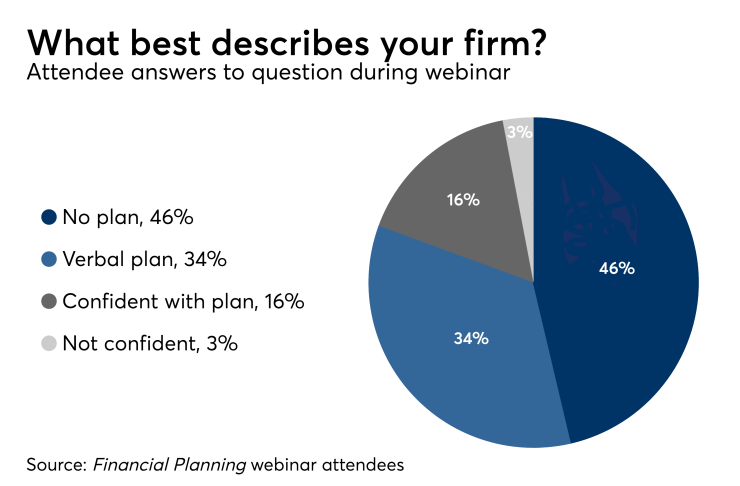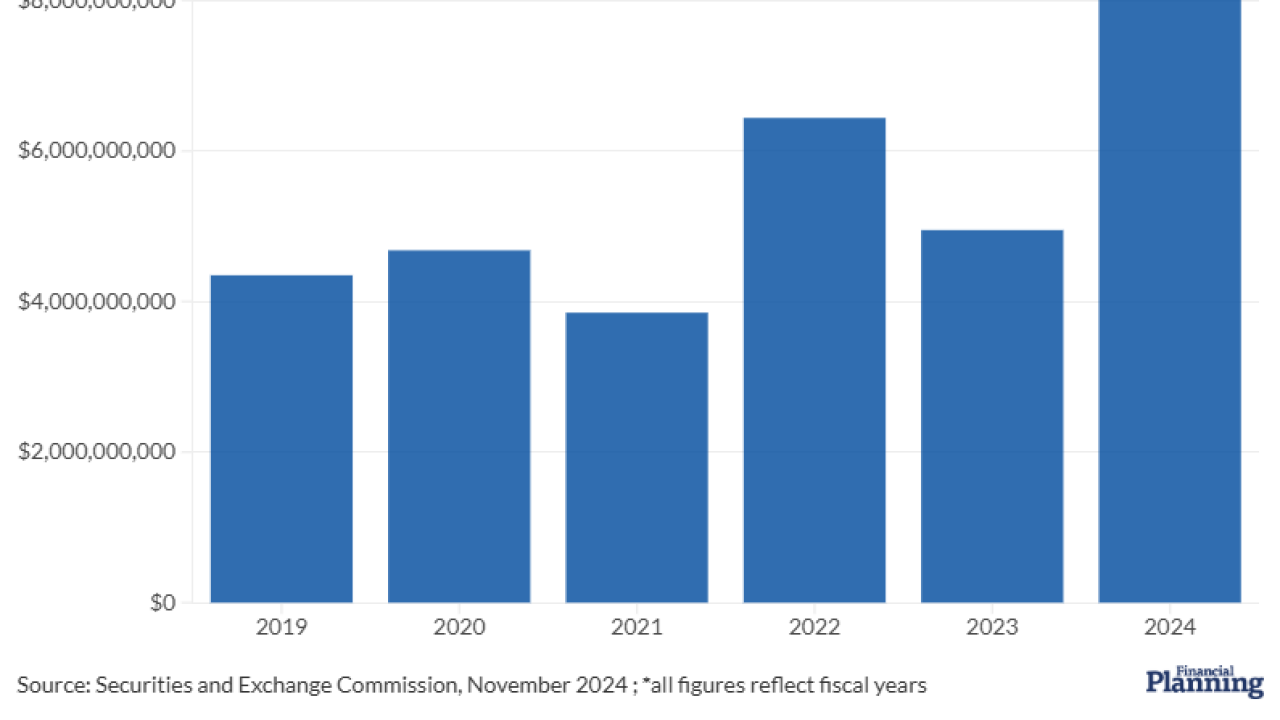Ready or not: The time to begin a succession planning process is now.
“You have to start this process before you think you are really ready to,” says Tim Chase, cofounder of WMS Partners in Towson, Maryland, who has experienced the succession process firsthand. “The earlier you start, the more successful you are going to be."
Chase spoke along with David DeVoe, founder of consulting practice DeVoe & Co., for a Financial Planning webinar on the tricky topic. DeVoe's firm helps guide advisers through the process, often over the course of years.

For a sense of just how reluctant firms are to address the issue, consider the results of a polling question offered to the 140 participants during the webinar.
More than 80% of those who responded said they either had no plan or had one that was only verbal. Chase said he was not surprised.
“One of the challenges we have in the industry is procrastination,” Chase says. Empty promises are another problem, he says. “The best people who have heard, ‘Hey, you’re my successor ... I am going to be sharing equity with you.' They hear that long enough and eventually they starting looking in other places.”
The responses from webinar attendees roughly track the results of other studies about the issue. In Fidelity’s most
Advisers who don’t have succession plans are also jeopardizing their ability to get the best price for their firm if they decide to sell it down the road. They also risk losing clients, who worry about the continuity of their financial plans should their adviser step aside suddenly.
Luckily, starting the success planning process may be easier than it seems. Regardless of a firm's size, there are key building blocks for creating a successful succession plan, DeVoe says.
M&A
The first step for owners is deciding whether they plan to pursue a merger or acquisition, either now or in the future. A delayed plan will result in forced, halfhearted, deals, DeVoe cautions.
Sole practitioners, as well as most large RIAs have to sell externally, he adds. Medium-size RIAs and some larger firms can potentially have an internal succession, depending on whether they have a qualified successor or not.
The worst case scenario: firms that prefer to sell internally, but lacking a successor who can afford other people’s stake. This results in the firm discounting its shares, hurting overall valuation, DeVoe says.
“Unfortunately, a lot of firms in the industry are not aware of this reality,” he says. “As a result we have a curve in the industry where the very small firms can’t sell internally and the very large firms can’t sell internally either.”
Building blocks
After advisers determine whether they will sell internally or externally, there are four key steps they can follow to build a succession plan: the fundamental plan, choosing a successor, creating a tailored agreement and the transition.
Fortunately, most advisers do not need to spend much time on a fundamental plan. They just need to start methodically naming milestones that will help a firm prioritize and create a strategy to follow, DeVoe says.
When it comes to choosing a successor, DeVoe says advisers should first identify the characteristics of an ideal candidate. Do this before they ask themselves if anyone on their staff could be a possible successor. By identifying the characteristics first, advisers can coach their staff in those areas and actually create a potential successor.
It is important for advisers to not look for a candidate who replicates them, DeVoe cautions.
“Your successor is not you minus 20 years,” he says. “That was a different person for a different time.” Successors should be chosen based on their technical capabilities, management skills and leadership qualities.
Once advisers choose a firm or individual to be their successors, they can solidify their transition by creating a tailored agreement.
Advisers will need to get an evaluation for their firm, DeVoe says. Sometimes firms will give their successors a number and the successor will agree to it. He says that is not the way to go.
“When people are risking their life savings,” DeVoe says. “It is important to get that number right.” The best way to evaluate RIAs is based on discounted cash flows, he says.
-
Whether the plan is to groom from within or look outside, keep these tips in mind.
May 23 -
Having gone through the lengthy and draining process, Exencial Wealth Advisors’ Michelle Scarver shares her No. 1 piece of advice for fellow planners.
May 12 -
Following these steps will help advisers prepare their firms for the future without them.
April 10
After the tailored agreement is settled, DeVoe says that advisers need think about transition steps. This involves figuring out how clients will be migrated and what the governance structure will be.
Chase says his firm successfully differentiated its self from competitors by creating enterprise value for its future customers in their succession plan. If they hadn’t done so, he says, there would have been nothing separating his firm from other firms.
And even after following these four steps religiously, the process doesn’t end.
“The reality is that everyone’s succession plan is going to continually evolve every couple years,” says DeVoe. Your firm continues to evolve and the people in your firm continue to evolve.”
Reinforcing DeVoe’s point, Chase says, “Quite simply what it comes down to is dialogue. You have to create that dialogue.”





